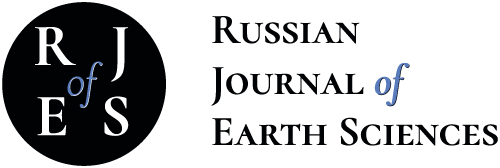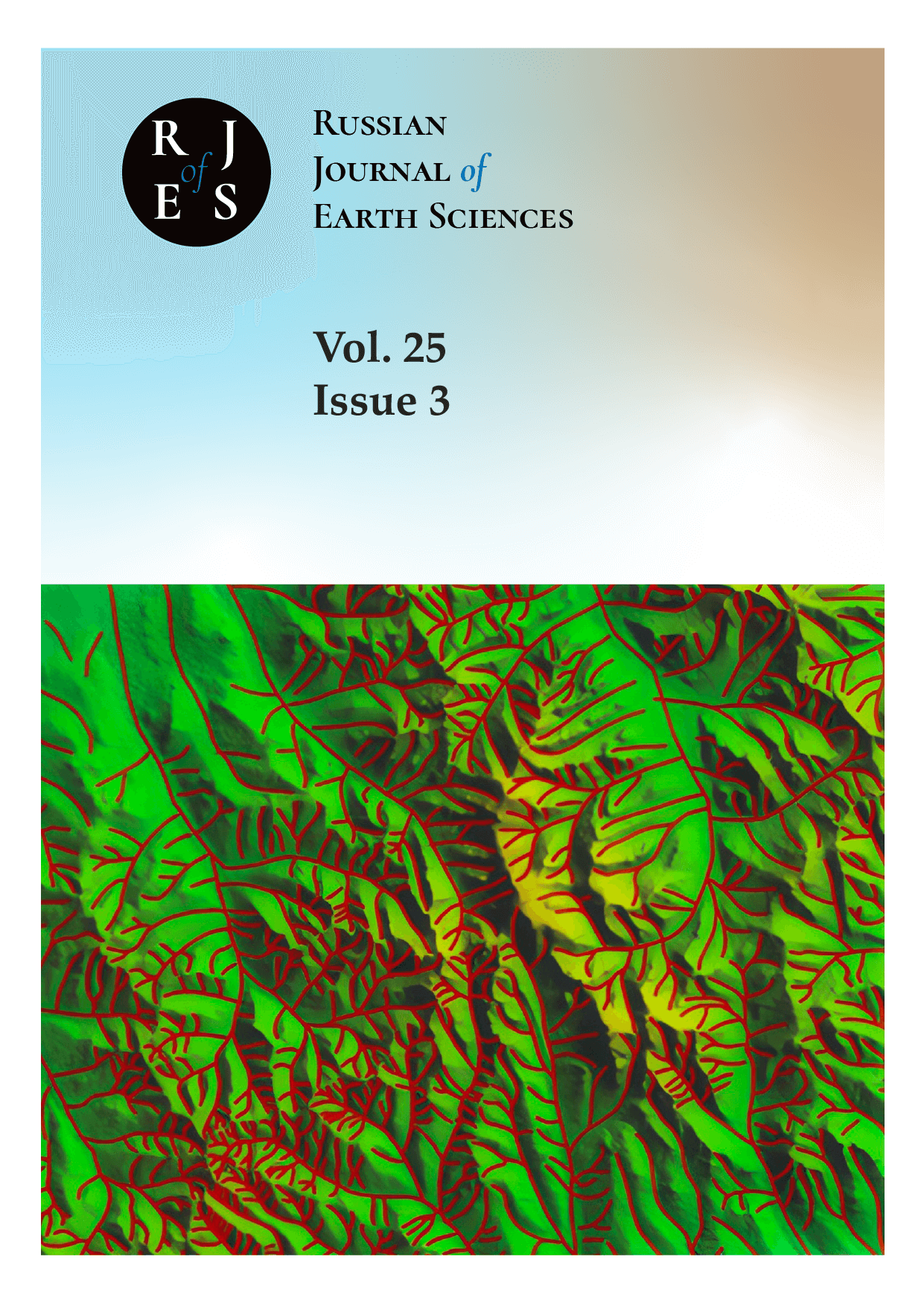from 01.01.2000 until now
Apatity, Murmansk, Russian Federation
Moscow, Moscow, Russian Federation
VAK Russia 1.6.1
VAK Russia 1.6
UDC 550.4
UDC 553.493.34
UDC 55
UDC 550.34
UDC 550.383
CSCSTI 38.33
CSCSTI 38.41
CSCSTI 38.57
CSCSTI 38.49
CSCSTI 37.01
CSCSTI 37.15
CSCSTI 37.25
CSCSTI 37.31
CSCSTI 38.01
CSCSTI 36.00
CSCSTI 37.00
CSCSTI 38.00
CSCSTI 39.00
CSCSTI 52.00
Russian Classification of Professions by Education 05.00.00
Russian Library and Bibliographic Classification 26
Russian Trade and Bibliographic Classification 63
BISAC SCI SCIENCE
The Sm-Nd geochronological study was performed to investigate rare-metal pegmatites from the two unique deposits, i.e., the Kolmozero lithium deposit and Shongui deposit with beryllium mineralization (Kola Peninsula, Russia). For Kolmozero lithium deposit was obtained the Sm-Nd isochrone, corresponding to an age of 1705 ± 60 Ma with high εNd(T ) = +9.1. For Shongui beryllium deposit was obtained the Sm-Nd age, corresponding to an age of 1747 ± 33 Ma with high εNd(T ) = +9.7. This age values are close to the ages of metamorphism obtained earlier by Rb-Sr, K-Ca, and K-Ar methods. Pegmatites are characterized by a wide range of εNd(T ) values from +2 to +16 and 147Sm/144Nd ratios up to 0.3. Possible reasons for disturbance of the Sm-Nd isotope system of pegmatites are analyzed, including multicomponent mixing, fluid influence and metamorphic overprinting. The highly radiogenic signatures of rare metal pegmatites of the Shongui and Kolmozero deposits were found to appear by fractionation of Nd and Sm and their different redistribution with the change of the Sm/Nd ratio. High εNd(T ) values and changes in Sm/Nd ratios indicate the role of REE (rare-earth element) fractionation, while narrow εNd(T ) ranges suggest interaction with fluids during pegmatite formation. These findings emphasize the need for further research into the composition of fluids and their influence on isotope systems.
Kolmozero lithium deposit, Shongui beryllium deposit, rare-metal pegmatites, LCT-type, spodumene, beryl, Sm-Nd age, REE
1. Antonyuk, E. S. (1962), Structural-mineral associations of granite pegmatite veins, in Materials on Mineralogy of the Kola Peninsula, pp. 134–142, Kola Branch of the USSR Academy of Sciences, Apatity, USSR (in Russian).
2. Barker, S. L. L., V. C. Bennett, S. F. Cox, et al. (2009), Sm-Nd, Sr, C and O isotope systematics in hydrothermal calcite-fluorite veins: Implications for fluid-rock reaction and geochronology, Chemical Geology, 268(1–2), 58–66, https://doi.org/10.1016/j.chemgeo.2009.07.009.
3. Bouvier, A., J. D. Vervoort, and P. J. Patchett (2008), The Lu-Hf and Sm-Nd isotopic composition of CHUR: Constraints from unequilibrated chondrites and implications for the bulk composition of terrestrial planets, Earth and Planetary Science Letters, 273(1–2), 48–57, https://doi.org/10.1016/j.epsl.2008.06.010.
4. Černý, P., and T. S. Ercit (2005), The classification of granitic pegmatites revisited, The Canadian Mineralogist, 43(6), 2005–2026, https://doi.org/10.2113/gscanmin.43.6.2005.
5. Cliff, R. A., and D. Rickard (1992), Isotope systematics of the Kiruna magnetite ores, Sweden; Part 2, Evidence for a secondary event 400 m.y. after ore formation, Economic Geology, 87(4), 1121–1129, https://doi.org/10.2113/gsecongeo.87.4.1121.
6. Daly, J. S., V. V. Balagansky, M. J. Timmerman, et al. (2006), The Lapland-Kola orogen: Palaeoproterozoic collision and accretion of the northern Fennoscandian lithosphere, Geological Society, London, Memoirs, 32(1), 579–598, https://doi.org/10.1144/gsl.mem.2006.032.01.35.
7. Dittrich, T. (2017), Meso- to Neoarchean Pegmatites (Western Australia, Zimbabwe) and a Genetic Model for the Formation of Massive Pollucite Mineralisations, phdthesis, Technischen Universität Bergakademie, Freiberg.
8. Dittrich, T., T. Seifert, B. Schulz, et al. (2019), Archean Rare-Metal Pegmatites in Zimbabwe and Western Australia: Geology and Metallogeny of Pollucite Mineralisations, Springer International Publishing, https://doi.org/10.1007/978-3-030-10943-1.
9. Garba, I. (2003), Geochemical discrimination of newly discovered rare-metal bearing and barren pegmatites in the Pan-African (600 ± 150 Ma) basement of northern Nigeria, Applied Earth Science, 112(3), 287–292, https://doi.org/10.1179/037174503225011270.
10. Glebovitsky, V. A. (Ed.) (2005), Early Precambrian of the Baltic shield, 711 pp., Nauka, Saint-Petersburg (in Russian).
11. Hölttä, P., V. Balagansky, A. A. Garde, et al. (2008), Archean of Greenland and Fennoscandia, Episodes, 31(1), 13–19, https://doi.org/10.18814/epiiugs/2008/v31i1/003.
12. Janots, E., H. Austrheim, C. Spandler, et al. (2018), Rare earth elements and Sm-Nd isotope redistribution in apatite and accessory minerals in retrogressed lower crust material (Bergen Arcs, Norway), Chemical Geology, 484, 120–135, https://doi.org/10.1016/j.chemgeo.2017.10.007.
13. Kudryashov, N., O. Udoratina, A. Kalinin, et al. (2022), U-Pb (SHRIMP-RG) age of zircon from rare-metal (Li, Cs) pegmatites of the Okhmylk deposit of the Kolmozero-Voron’ya greenstone belt (northeast of the Fennoscandian shield), Journal of Mining Institute, 255, 448–454, https://doi.org/10.31897/pmi.2022.41.
14. Lahtinen, R., and H. Huhma (2019), A revised geodynamic model for the Lapland-Kola Orogen, Precambrian Research, 330, 1–19, https://doi.org/10.1016/j.precamres.2019.04.022.
15. Lahtinen, R., A. A. Garde, and V. A. Melezhik (2008), Paleoproterozoic evolution of Fennoscandia and Greenland, Episodes, 31(1), 20–28, https://doi.org/10.18814/epiiugs/2008/v31i1/004.
16. Li, X.-C., K.-F. Yang, C. Spandler, et al. (2021), The effect of fluid-aided modification on the Sm-Nd and Th-Pb geochronology of monazite and bastnäsite: Implication for resolving complex isotopic age data in REE ore systems, Geochimica et Cosmochimica Acta, 300, 1–24, https://doi.org/10.1016/j.gca.2021.02.028.
17. Li, X.-C., D. E. Harlov, M.-F. Zhou, et al. (2022a), Experimental investigation into the disturbance of the Sm-Nd isotopic system during metasomatic alteration of apatite, Geochimica et Cosmochimica Acta, 330, 191–208, https://doi.org/10.1016/j.gca.2021.04.036.
18. Li, Z.-X., S.-B. Zhang, Y.-F. Zheng, et al. (2022b), Mobilization and fractionation of HFSE and REE by high fluorine fluid of magmatic origin during the alteration of amphibolite, Lithos, 420–421, 106,701, https://doi.org/10.1016/j.lithos.2022.106701.
19. Li, Z.-X., S.-B. Zhang, Y.-F. Zheng, et al. (2024), Homogenization of Hf-Nd isotopes induced by hydrothermal fluids during the differentiation of granitic magmas into pegmatites, Chemical Geology, 670, 122,455, https://doi.org/10.1016/j.chemgeo.2024.122455.
20. Migdisov, A., A. E. Williams-Jones, J. Brugger, et al. (2016), Hydrothermal transport, deposition, and fractionation of the REE: Experimental data and thermodynamic calculations, Chemical Geology, 439, 13–42, https://doi.org/10.1016/j.chemgeo.2016.06.005.
21. Migdisov, A. A., A. E. Williams-Jones, and T. Wagner (2009), An experimental study of the solubility and speciation of the Rare Earth Elements (III) in fluoride- and chloride-bearing aqueous solutions at temperatures up to 300◦C, Geochimica et Cosmochimica Acta, 73(23), 7087–7109, https://doi.org/10.1016/j.gca.2009.08.023.
22. Mints, M. V., K. A. Dokukina, A. N. Konilov, et al. (2015), 2. Mesoarchean Kola-Karelia continent, in East European Craton: Early Precambrian History and 3D Models of Deep Crustal Structure, pp. 15–88, Geological Society of America, Boulder, Colorado, https://doi.org/10.1130/2015.2510(02).
23. Morozova, L. N. (2018), Lithium Kolmozero deposit of rare metal pegmatites: New data on rare element composition (Kola Peninsula), Lithosfera, 18(1), 82–98, https://doi.org/10.24930/1681-9004-2018-18-1-082-098 (in Russian).
24. Morozova, L. N., T. B. Bayanova, A. V. Bazay, et al. (2017), Rare metal pegmatites of the Kolmozero lithium deposit of the Arctic region of the Baltic shield: New geochronological data, Vestnik KSC RAS, 9(1), 43–52 (in Russian), EDN: https://elibrary.ru/YKJYGL.
25. Morozova, L. N., E. N. Sokolova, S. Z. Smirnov, et al. (2020), Spodumene from rare-metal pegmatites of the Kolmozero lithium world-class deposit on the Fennoscandian shield: trace elements and crystal-rich fluid inclusions, Mineralogical Magazine, 85(2), 149–160, https://doi.org/10.1180/mgm.2020.104.
26. Morozova, L. N., D. R. Zozulya, E. Selivanova, et al. (2022), Distribution of Trace Elements in K-Feldspar with Implications for Tracing Ore-Forming Processes in Pegmatites: Examples from the World-Class Kolmozero Lithium Deposit, NW Russia, Minerals, 12(11), 1448, https://doi.org/10.3390/min12111448.
27. Morozova, L. N., S. G. Skublov, D. R. Zozulya, et al. (2023), Li-Cs-Na-Rich Beryl from Beryl-Bearing Pegmatite Dike No. 7 of the Shongui Deposit, Kola Province, Russia, Geosciences, 13(10), 309, https://doi.org/10.3390/geosciences13100309.
28. Morozova, L. N., D. R. Zozulya, and S. G. Skublov (2024), Kola rare-metal pegmatite belt - the most important source of strategic mineral raw materials (Li, Be, Nb, Ta, Cs) in Russia, Prospect & protection of mineral resources, (2), 36–40, https://doi.org/10.53085/0034-026x_2024_2_36.
29. Petersson, A., U. Söderlund, A. Scherstén, et al. (2023), The robustness of the Lu-Hf and Sm-Nd isotopic systems during metamorphism - A case study of the Åker metabasite in southern Sweden, Precambrian Research, 394, 107,122, https://doi.org/10.1016/j.precamres.2023.107122.
30. Poitrasson, F., J.-L. Paquette, J.-M. Montel, et al. (1998), Importance of late-magmatic and hydrothermal fluids on the Sm-Nd isotope mineral systematics of hypersolvus granites, Chemical Geology, 146(3–4), 187–203, https://doi.org/10.1016/S0009-2541(98)00010-2.
31. Polkanov, A. A., and E. K. Gerling (1961), Geochronology and geological evolution of the Baltic Shield and its folded framing, Trudy Laboratory of Precambrian Geology, Academy of Sciences of the USSR, 12, 101–102 (in Russian).
32. Ponomareva, N. I., V. V. Gordienko, and R. S. Shurekova (2005), Physicochemical Circumstances of Beryl Generation in "Bol’Shoy Lapot" Deposit (Kola Peninsula), Bulletin of the Saint Petersburg State Institute of Technology, (3), 4–20 (in Russian), EDN: https://elibrary.ru/UXOJDP.
33. Pushkarev, Y. D. (1990), Megacycles in evolution of crust-mantle system, 217 pp., Nauka, St. Petersburg (in Russian).
34. Pushkarev, Y. D., E. V. Kravchenko, and G. I. Shestakov (1978), Geochronologic repertoires in the Precambrian of the Baltic Shield, 136 pp., Nauka, Leningrad (in Russian).
35. Raczek, I., K. P. Jochum, and A. W. Hofmann (2003), Neodymium and Strontium Isotope Data for USGS Reference Materials BCR-1, BCR-2, BHVO-1, BHVO-2, AGV-1, AGV-2, GSP-1, GSP-2 and Eight MPI-DING Reference Glasses, Geostandards Newsletter, 27(2), 173–179, https://doi.org/10.1111/j.1751-908x.2003.tb00644.x.
36. Romer, R. L. (1996), U-Pb systematics of stilbite-bearing low-temperature mineral assemblages from the Malmberget iron ore, northern Sweden, Geochimica et Cosmochimica Acta, 60(11), 1951–1961, https://doi.org/10.1016/0016-7037(96)00066-x.
37. Salerno, R., J. Vervoort, C. Fisher, et al. (2021), The coupled Hf-Nd isotope record of the early Earth in the Pilbara Craton, Earth and Planetary Science Letters, 572, 117,139, https://doi.org/10.1016/j.epsl.2021.117139.
38. Tanaka, T., S. Togashi, H. Kamioka, et al. (2000), JNdi-1: a neodymium isotopic reference in consistency with LaJolla neodymium, Chemical Geology, 168(3–4), 279–281, https://doi.org/10.1016/s0009-2541(00)00198-4.
39. Timmerman, M. J., and J. S. Daly (1995), Sm-Nd evidence for late Archaean crust formation in the Lapland-Kola Mobile Belt, Kola Peninsula, Russia and Norway, Precambrian Research, 72(1–2), 97–107, https://doi.org/10.1016/0301-9268(94)00045-s.
40. Vermeesch, P. (2018), IsoplotR: A free and open toolbox for geochronology, Geoscience Frontiers, 9(5), 1479–1493, https://doi.org/10.1016/j.gsf.2018.04.001.
41. Vezinet, A., D. G. Pearson, and E. Thomassot (2021), Effects of contamination on whole-rock isochrons in ancient rocks: A numerical modelling approach, Lithos, 386–387, 106,040, https://doi.org/10.1016/j.lithos.2021.106040.
42. Vrevsky, A. B., and A. P. Lvov (2016), Isotopic age and heterogeneous sources of gabbro-anorthosites from the Patchemvarek massif, Kola Peninsula, Doklady Earth Sciences, 469(1), 716–721, https://doi.org/10.1134/s1028334x16070163.
43. Wang, D., S. B. Shirey, R. W. Carlson, et al. (2022), Comparative Sm-Nd isotope behavior of accessory minerals: Reconstructing the Sm-Nd isotope evolution of early Archean rocks, Geochimica et Cosmochimica Acta, 318, 190–212, https://doi.org/10.1016/j.gca.2021.11.031.
44. Westhues, A., J. M. Hanchar, C. R. Voisey, et al. (2017), Tracing the fluid evolution of the Kiruna iron oxide apatite deposits using zircon, monazite, and whole rock trace elements and isotopic studies, Chemical Geology, 466, 303–322, https://doi.org/10.1016/j.chemgeo.2017.06.020.
45. Yan, S., B. Wan, and U. B. Andersson (2023), Hydrothermal circulation at 1.8 Ga in the Kiruna area, northern Sweden, as revealed by apatite geochemical systematics, Precambrian Research, 395, 107,151, https://doi.org/10.1016/j.precamres.2023.107151.
46. Zhang, H.-X., S.-Y. Jiang, S.-Q. Liu, et al. (2023), Sm-Nd and U-Pb isotope behavior of REE-rich accessory minerals in pegmatite during overprinted metamorphic and hydrothermal events: Evidence from the Paleoproterozoic rare-earth pegmatite in the lesser Qinling district of China, Precambrian Research, 389, 107,020, https://doi.org/10.1016/j.precamres.2023.107020.
47. Zozulya, D., L. N. Morozova, K. Kullerud, et al. (2024), Nb-Ta-Sn Oxides from Lithium-Beryllium-Tantalum Pegmatite Deposits of the Kolmozero-Voronja Belt, NW Russia: Implications for Tracing Ore-Forming Processes and Mineralization Signatures, Geosciences, 14(1), https://doi.org/10.3390/geosciences14010009.















